Orthodontists and dentists chalk up our high rates of crooked teeth, misaligned jaws, and deviated septums to “bad genetics”, but when we take a look at the research, this simply doesn’t add up.
90% of children have some sort of nasal or oral deformity that gets in the way of proper breathing. Meanwhile, anthropological studies find practically no evidence of misaligned teeth or blocked airways in ancient, pre-agrarian times.[b][f]
Despite having no braces, retainers, or invasive surgeries, it seems likely that humans somehow managed to have straight teeth, healthy jaws, and open airways.
While there are a lot of factors that caused this change, our worsening oral posture is both the one that we have the most control over and the one that impacts our breathing the most.
Just like our body posture, our oral posture has deteriorated over time.[n] And while we’re quick to talk about the benefits of good body posture, oral posture usually flies under the radar.
In reality, good oral posture is just as important for our overall health as body posture, especially because of the impact it has on our breathing.
How bad oral posture affects our health and our breathing
In an ideal world, the air you inhale has plenty of room to travel down the throat and to the lungs. There’s a clear, open pathway for the billions of molecules of air to make its way to the lungs.
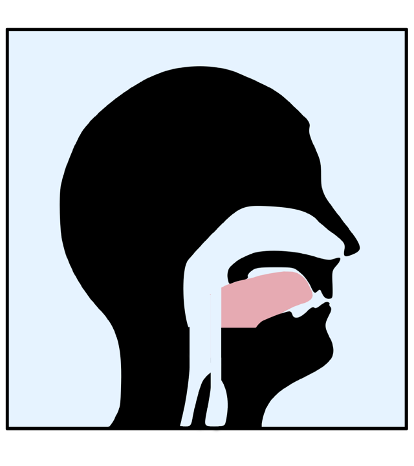
Unfortunately, most of us, especially mouthbreathers, have a pesky obstacle that blocks the air from having a clear path to the lungs – our own tongue!
That’s right, as you can see in the diagram below, for those of us with bad oral posture, our own tongue gets in the way of our breathing (the big pink thing represents our tongue – see how it blocks the airway in yellow?).
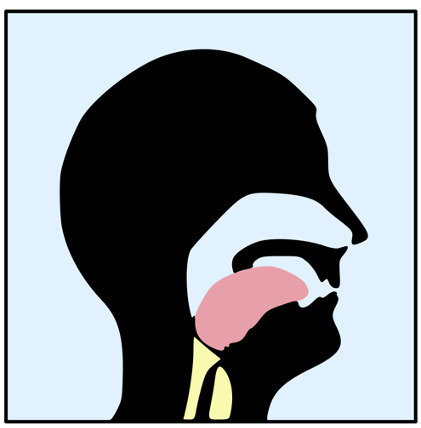
In addition to blocking the airway, this poor tongue posture is the root cause of a myriad of different issues.
1. Snoring, sleep apnea, and insomnia
Snoring and sleep apnea are highly related to an improper position of the tongue. When the tongue rests in this position during sleep, you’re essentially choking on your own tongue.
In the case of snoring, it creates an unpleasant noise that can wake you up, and in the case of sleep apnea you’re actually choking on your own tongue, which causes you to wake up.
2. Mouth breathing
Nose breathing is ideal because it leads to higher quality air, more efficient oxygen delivery, and a host of other health benefits.
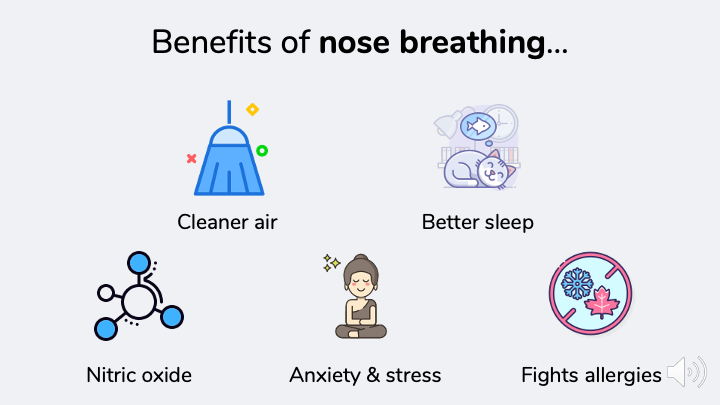
But nose breathing becomes incredibly challenging when our tongue partially blocks our airway.
When nose breathing becomes difficult, what do we do? Well, we resort to mouth breathing, which further contributes to bad tongue posture. Try breathing out of your mouth while touching your tongue to the roof of your mouth – not so easy, is it? That’s why the tongue drops down into the throat when we mouth breathe.
Mouth breathing is both a symptom and a cause of improper oral posture – bad oral posture leads to mouth breathing, and mouth breathing leads to bad oral posture.
A study of over 3,000 children found that those that mouth-breathed were considerably more likely to have misaligned teeth, overbites, crossbites, and other dental issues.[1]
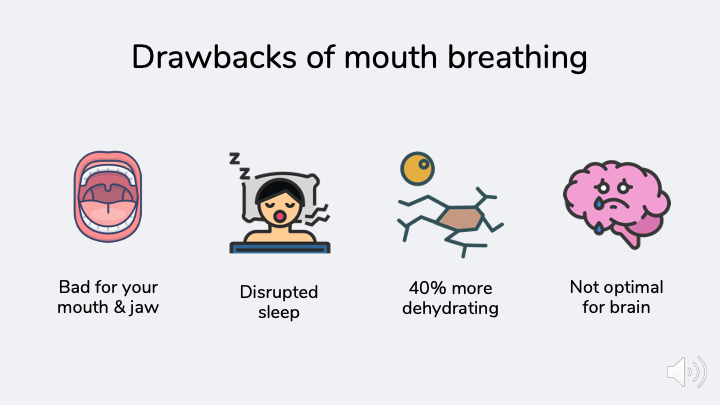
I won’t go into all the downsides of mouth breathing here, for that, you can check out my full article on why nose breathing is better breathing, but in short, mouth breathing leads to lower quality air, less oxygen, dehydration, and an imbalance of oxygen to certain parts of the brain.
Mouth breathing leads to lower quality air, less oxygen, dehydration, and an imbalance of oxygen to certain parts of the brain.
3. Jaw and teeth abnormalities
As James Nestor discusses in his book, Breath, our jaw and teeth rely on pressure from our tongue to grow and develop properly. The pressure exerted by our tongue pressing up against the roof of our mouth acts as a natural force to stimulate proper jaw growth and teeth alignment.
It’s a huge part of the reason jaws and palettes have become smaller over time.
Improper oral posture also contributes to the staggering fact that 90% of children have some sort of jaw, teeth, or nasal deformity. Meanwhile nearly half of all adults have a deformed jaw.[2][3] Interestingly, anthropologists find practically no evidence of crooked teeth or small palettes when they analyze the skulls of ancient cultures.[f]
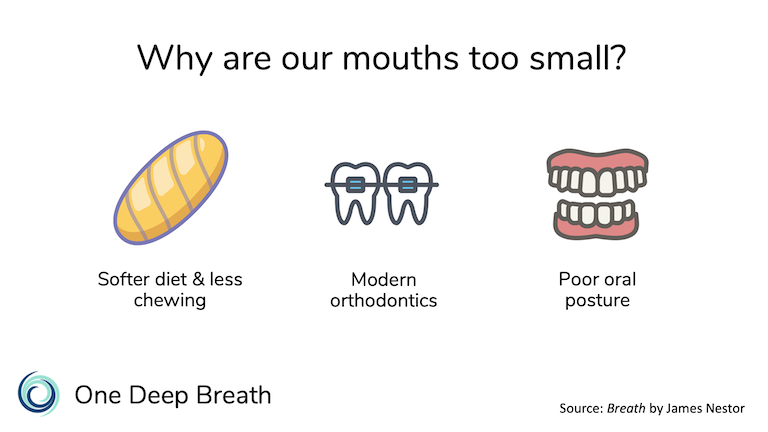
There’s a lot of speculation about the other causes of these dental, jaw, and nasal issues. Many experts believe it’s due to our transition towards a softer diet. In paleolithic times we would spend a great deal of time chewing meat off bones, strengthening our teeth, and expanding our jaw by triggering the growth of stem cells. Other experts believe that modern orthodontic devices create artificially small mouths that can’t properly hold the tongue.
Whatever the case may be, our oral posture plays a significant role in how our jaw develops and where our tongue rests, which affects our breathing and our health .
Correct Oral Posture 101
While we can’t necessarily go back to chewing meat off the bone or reverse the decades of orthodontic damage, we can alter our oral posture for better breathing.
The biggest thing we need to do to make breathing and sleeping easier is to get our tongue out of the way.
So, let’s do a quick check of your oral posture…
- Is your tongue touching the roof of your mouth, near the front teeth?
- Are your back teeth lightly touching, or nearly touching (the front teeth should not be touching)?
- Are your lips gently sealed?
If you answered yes to all of these questions, you probably have pretty decent oral posture already.
1. Tongue touching the roof of the mouth behind the teeth
In essence, you want your tongue to be out of the way of your airway – to do this, you need to have your tongue touching the roof of your mouth, where it should naturally rest.
You don’t want to be pressing against your teeth, and you don’t need to apply a ton of pressure unless you’re deliberately trying to make it a habit. The goal is to be able to do this all the time.
You can try saying the letter “N” and holding it, like “Ennnnnnnn” to find your proper tongue placement.
Over time, this will feel more and more comfortable as your jaw naturally expands.
Ideally, you should have as much of your tongue as possible touch the roof of your mouth, but at the beginning, this might be tough.
2. Front teeth slightly apart, back teeth touching or nearly touching
You also don’t want your teeth to be clenched – the back teeth should either be lightly touching, or very slightly apart, while your front teeth should be slightly apart.
3. Sealed lips
Finally, your lips should be gently sealed, but you should have to force it – if you do everything right, the lips should close pretty effortlessly and naturally.
This will optimize your mouth for proper breathing, but may also help with jaw and teeth alignment too.
Bonus Tip: Chew!
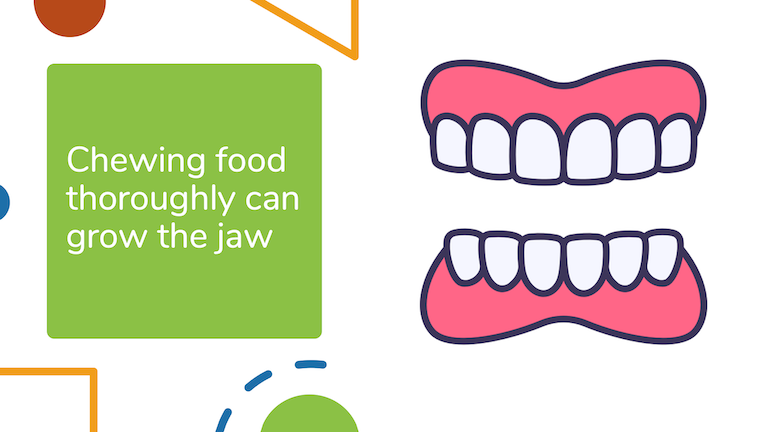
Chewing your food thoroughly and completely (but not too forcefully!) leads to the stimulation and growth of stem cells in the jaw.[b]
Over time this can help strengthen, expand, and optimize the jaw for better breathing.
If you’re someone who consumes a lot of juices or smoothies, you might want to opt for eating the actual vegetables or fruit instead to strengthen the jaw.
Body posture is important for breathing too
In addition, your body posture is just as important as your oral posture for breathing correctly.
One study showed that there were significant differences in the volume of air taken in when slouched versus upright.[4]
As you can see in the diagram below if your head is tilted too far back or too far forwards, the airway becomes kinked and constricted right where you’re supposed to be inhaling oxygen.
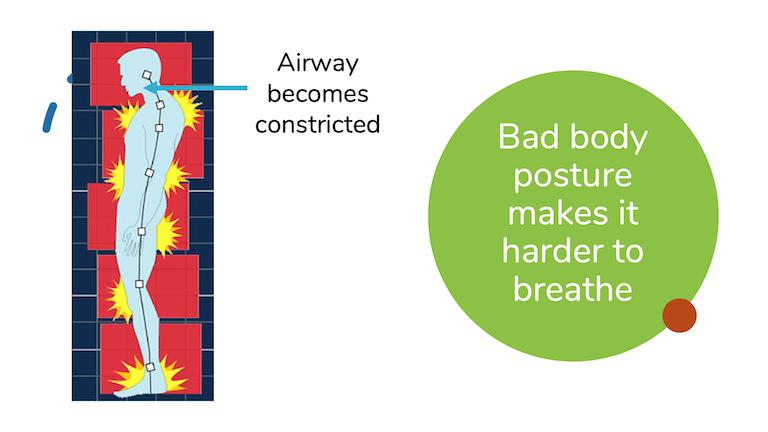
This head alignment is more so a side-effect of your overall posture, as opposed to an isolated incident.
Most of us lean forward too much, due to the amount of time we spend working at desks, looking at screens, and moving our head down to check our phones, so it’s more common to have “nerd neck”, which can affect your breathing.
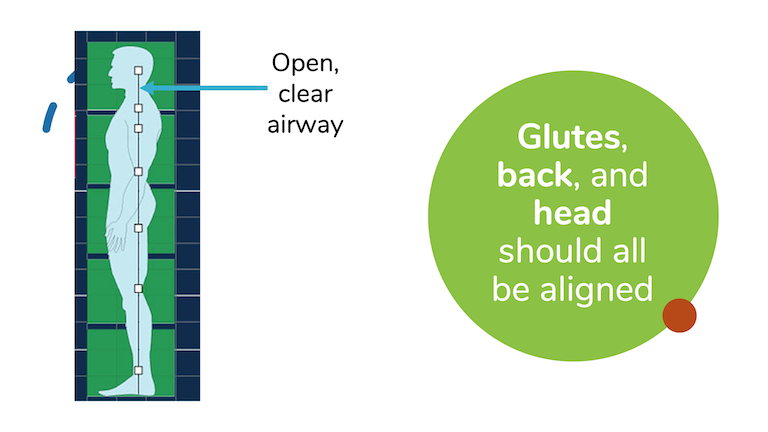
The easiest way to get into proper posture is to stand against a wall with your head, back, and glutes (butt) touching the wall. Hold this position for a few seconds – if you don’t regularly stand like this, you might feel tension in your abs or glutes.
Now, step away from the wall. This is essentially how your posture should be all the time, with the obvious exception of sitting down, where everything above your hips should maintain this same posture.
Putting it all together
Better breathing isn’t the only reason proper oral and body posture is important, but it’s certainly a big one.
It’s important to understand that changing your posture isn’t going to come easily or show immediate benefits – it’s something that needs to take place over time, and it might not be the easiest habit to build.
Over time, as your oral and body posture improves, so will your breathing, your sleep, and your health.
If you want reminders to optimize your oral and body posture for better breathing, you can request early access to the One Deep Breath app and set personalized reminders to breathe when you need it most.
Sources
[b]: Nestor, James. Breath: the New Science of a Lost Art. Riverhead Books, 2020.
[f]: https://www.sciencedaily.com/releases/2015/02/150204144653.htm




